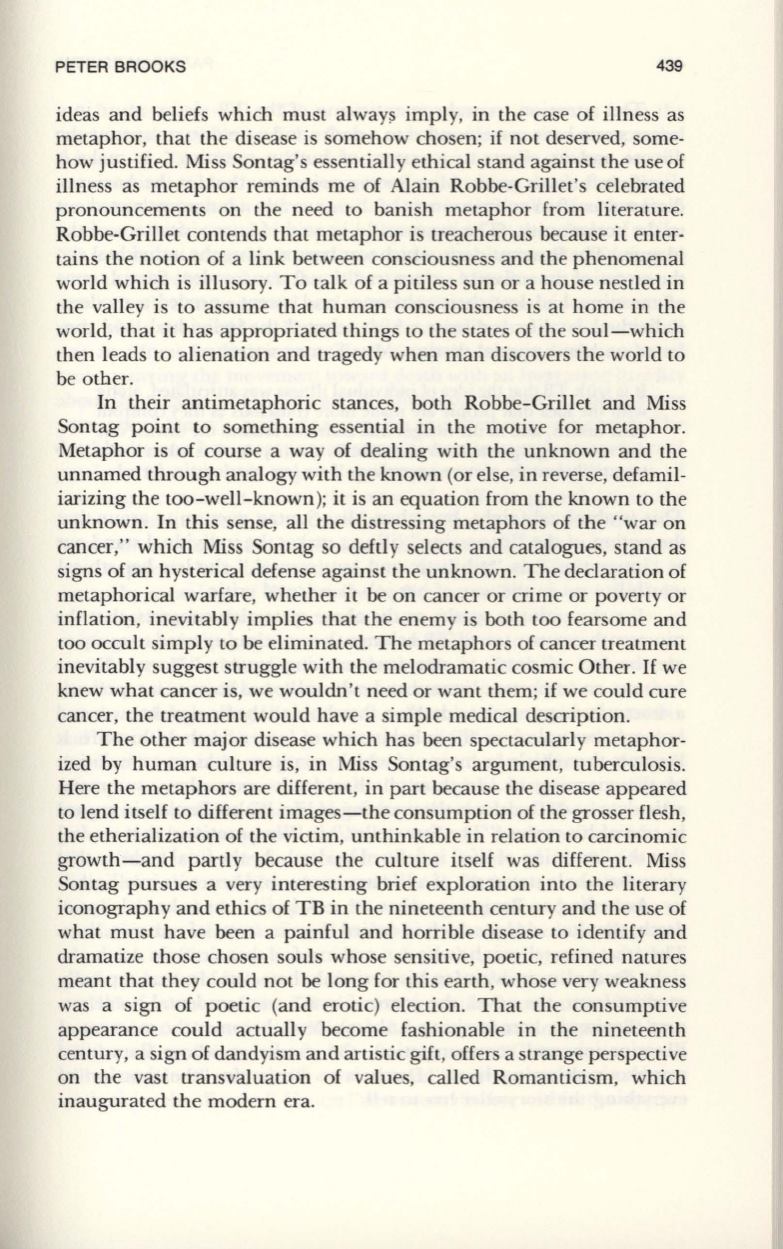
PETER BROOKS
439
ideas and beliefs which must
alway~
imply, in the case of illness as
metaphor, that the disease is somehow chosen; if not deserved, some–
how justified. Miss Sontag's essentially ethical stand against the use of
illness as metaphor reminds me of Alain Robbe-Grillet's celebrated
pronouncements on the need to banish metaphor from literature.
Robbe-Grillet contends that metaphor is treacherous because it enter–
tains the notion of a link between consciousness and the phenomenal
world which is illusory. To talk of a pitiless sun or a house nestled in
the valley is to assume that human consciousness is at home in the
world, that it has appropriated things to the states of the soul-which
then leads to alienation and tragedy when man discovers the world to
be other.
In their antimetaphoric stances, both Robbe-Grillet and Miss
Sontag point to something essential in the motive for metaphor.
Metaphor is of course a way of dealing with the unknown and the
unnamed through analogy with the known (or else, in reverse, defamil–
iarizing the too-well-known); it is an equation from the known to the
unknown. In this sense, all the distressing metaphors of the "war on
cancer," which Miss Sontag so deftly selects and catalogues, stand as
signs of an hysterical defense against the unknown. The declaration of
metaphorical warfare, whether it be on cancer or crime or poverty or
inflation, inevitably implies that the enemy is both too fearsome and
too occult simply to be eliminated. The metaphors of cancer treatment
inevitably suggest struggle with the melodramatic cosmic Other.
If
we
knew what cancer is, we wouldn't need or want them; if we could cure
cancer, the treatment would have a simple medical description.
The other major disease which has been spectacularly metaphor–
ized by human culture is, in Miss Sontag's argument, tuberculosis.
Here the metaphors are different, in part because the disease appeared
to lend itself to different images-the consumption of the grosser flesh ,
the etherialization of the victim, unthinkable in relation to carcinomic
growth-and partly because the culture itself was different. Miss
Sontag pursues a very interesting brief exploration into the literary
iconography and ethics of TB in the nineteenth century and the use of
what must have been a painful and horrible disease to identify and
dramatize those chosen souls whose sensitive, poetic, refined natures
meant that they could not
be
long for this earth, whose very weakness
was a sign of poetic (and erotic) election. That the consumptive
appearance could actually become fashionable in the nineteenth
century, a sign of dandyism and artistic gift, offers a strange perspective
on the vast transvaluation of values, called Romanticism, which
inaugurated the modern era.


